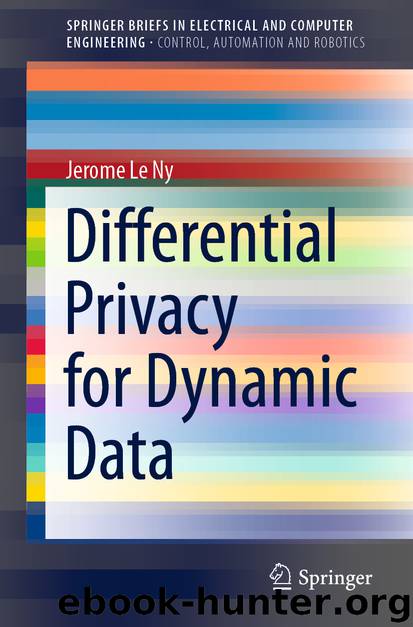Differential Privacy for Dynamic Data by Jerome Le Ny

Author:Jerome Le Ny
Language: eng
Format: epub
ISBN: 9783030410391
Publisher: Springer International Publishing
(4.7)
see Appendix A. Similarly, the signal y is WSS and the cross z-spectrum is
(4.8)
From Sect. 4.2, and in particular (4.2) and (4.6), knowledge of these z-spectra allows us to implement for H a linear smoother or filter minimizing among linear systems the MSE between y and on Fig. 3.2. Although other performance criteria than MSE could be appropriate to design H, such as maximum likelihood estimation, designing linear estimators minimizing the MSE typically leads to relatively tractable problems and is in some sense compatible with the performance measure (3.1). Hence, in this chapter, we study mechanisms where H is designed as a LMMSE estimator, which we call LMMSE mechanisms. This fixes the structure of H, and it then remains to optimize over the choice of G, following the general methodology outlined in Sect. 3.2.
There are still two main obstacles to the design of optimal LMMSE mechanisms. First, for systems F with multiple inputs, as for the ZFE mechanism of Chap. 3, we need to add white noise w on Fig. 3.2 proportional to the sensitivity of the filter G, for which we do not have a tractable formula. Hence, as in Sect. 3.4.2, we resort to optimizing over diagonal prefilters G only. Second, even for SISO systems, the expression of the MSE (3.1) is a complicated function of G when H is a causal Wiener filter, given by (4.6). Hence, we focus first on scenarios where H is a Wiener smoother, i.e., not necessarily causal, with the corresponding simpler expression (4.2). For the resulting simplified architecture, we can express the estimation performance analytically as a function of G. Optimizing this performance measure provides the best diagonal prefilter for a Wiener smoother H, and a lower bound on the performance achievable with any diagonal prefilter followed by a Wiener filter H.
For specific implementations of causal LMMSE mechanisms, two natural choices are then discussed. First, we can take the pre-filter G obtained from the computation of the lower bound assuming a Wiener smoother, and implement instead for H a causal Wiener filter, or perhaps a slightly non-causal filter if it can be implemented by introducing a delay that is tolerable for a specific application. This mechanism will not attain the lower bound in general, since the bound and corresponding G were obtained by removing the causality constraint on H. Another possibility is to take G as in the ZFE mechanism, and simply replace by a Wiener filter. This choice has the advantage of always improving on the ZFE mechanism, and tends to perform well in practice. For any specific implementation with diagonal prefilters, the lower bound on performance can be computed to provide an indication of how far the design might be from the optimal one.
Download
This site does not store any files on its server. We only index and link to content provided by other sites. Please contact the content providers to delete copyright contents if any and email us, we'll remove relevant links or contents immediately.
Grails in Action by Glen Smith Peter Ledbrook(9163)
Sass and Compass in Action by Wynn Netherland Nathan Weizenbaum Chris Eppstein Brandon Mathis(8808)
Azure Containers Explained by Wesley Haakman & Richard Hooper(7444)
Configuring Windows Server Hybrid Advanced Services Exam Ref AZ-801 by Chris Gill(7433)
Kotlin in Action by Dmitry Jemerov(7263)
Running Windows Containers on AWS by Marcio Morales(6984)
Microsoft 365 Identity and Services Exam Guide MS-100 by Aaron Guilmette(5402)
Microsoft Cybersecurity Architect Exam Ref SC-100 by Dwayne Natwick(5212)
Combating Crime on the Dark Web by Nearchos Nearchou(4981)
The Ruby Workshop by Akshat Paul Peter Philips Dániel Szabó and Cheyne Wallace(4670)
Management Strategies for the Cloud Revolution: How Cloud Computing Is Transforming Business and Why You Can't Afford to Be Left Behind by Charles Babcock(4527)
Python for Security and Networking - Third Edition by José Manuel Ortega(4233)
The Age of Surveillance Capitalism by Shoshana Zuboff(4209)
Learn Wireshark by Lisa Bock(4119)
The Ultimate Docker Container Book by Schenker Gabriel N.;(3888)
Learn Windows PowerShell in a Month of Lunches by Don Jones(3681)
DevSecOps in Practice with VMware Tanzu by Parth Pandit & Robert Hardt(3568)
Windows Ransomware Detection and Protection by Marius Sandbu(3541)
Blockchain Basics by Daniel Drescher(3507)
